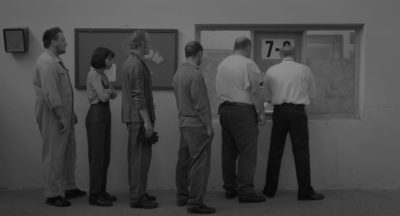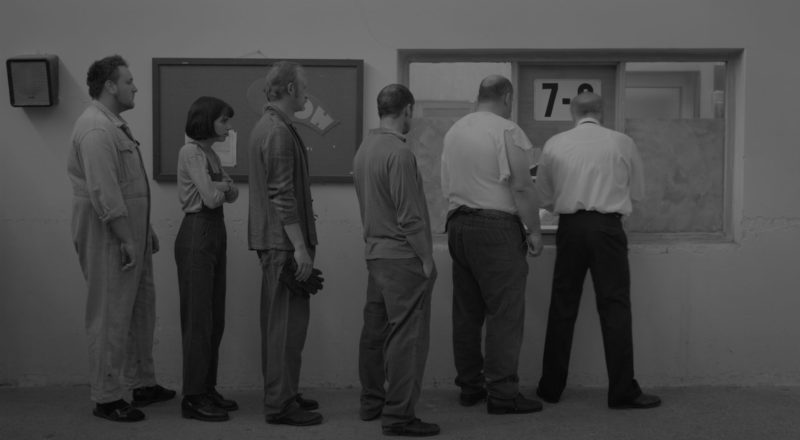INTERVIEW: New film depicts Olga Hepnarova’s turn to murder

I, Olga Hepnarova is the new movie from filmmakers Tomás Weinreb and Petr Kazda. The drama depicts the lonely life and ultimate rampage of a young woman who seems at odds with her family, her lovers and her society.
In stark black-and-white images, 22-year-old Hepnarova (Michalina Olszańka) goes about her life in 1970s Czechoslovakia almost as if the world is on a different wavelength. She is incapable of making connections with other people and doesn’t feel she fits in with her surroundings. Her strict family is disapproving of her depression and loneliness. Her mother is even depicted as making light of Olga’s attempted suicide, and eventually Olga devises a murderous plot to drive a rented truck into a group of approximately 25 people in Prague.
This actual incident led to the tragic death of eight people and resulted in Hepnarova being executed. In fact, she was the last woman to receive capital punishment in Czechoslovakia. “Olga Hepnarova was a young, lonely lesbian outsider from a coldhearted family who couldn’t play the part society desired of her,” the film’s press release states.
I, Olga Hepnarova is currently playing at the Village East in New York City. The movie was an official selection at the Berlin Film Festival, Guadalajara Film Festival, Hong Kong Film Festival and Sofia Film Festival.
Recently, Hollywood Soapbox exchanged emails with Weinreb and Kazda about the film, the real-life Hepnarova and working with Olszanka on the difficult role. Questions and answers have been slightly edited for style.
What inspired you to make a film about Olga Hepnarova?
We were shocked by the Olga’s story on one hand, and, on [the] other hand, we were inspired by existential authors like Albert Camus and Hermann Hesse. We continually had to defend ourselves and explain that we didn’t want to make a film about a mass murderer, but an existential drama. We had to no interest in sensationalism, were not going to glorify the murderer in our film, and our intention was just to show a human being and her dramatic fate. This uncompromising standpoint brought us challenges in one way, but now the film is done. And audiences are responding to it in the way which we intended.
Why did you choose to shoot the film in black and white?
Yes, from the beginning, we felt instinctually that we wanted this film to be shot in black-and-white. We felt it was important in portraying Olga Hepnarova’s story. The palette of shadows and mid-tones, using Panavision primo lenses, created a soft picture and simplicity that were crucial to the film.
What do you think modern-day audiences will take from the story of this woman and her horrible killing of eight people in Prague?
Olga’s story in some ways is a repeating reality when an individual aggressively turns against society. I personally think Olga would act the same way today, too, because it is not so crucial in which political situation or repression one lives. The crucial point is what kind of world he or she is able to build around him/herself. It is impossible to say what played the crucial role; in her case, it was her specific set of experiences at that period in her life.
After Olga Hepnarova failed in building a world around herself — for example, at the cottage in Oleška in a relationship with a partner, she created her own moral code. She simply stopped being aware of the profane Communist reality and replaced it with her own. Of course, one should ask why that transpired and why she did [commit] the crime, and the film reflects on that, too. Olga thought that when she broke away from the world which she found evil and aggressive, she would gain her own freedom. But that was a mistake; it only created other personal limits and barriers for her. And finally the incompatibility of the two worlds led to the tragedy.
What did actress Michalina Olszańka bring to the part of Olga?
Michalina joined the project a relatively short time before the start of filming. We had been looking for her for a long time. At the beginning it was difficult, but when we got clear with Michalina during the first week of shooting about the attitude and personality of the character, the rest was easy. Michalina simply immersed herself in Olga and became Olga.
Her powers of concentration were incredible. She didn’t talk to anyone. During breaks, she prepared for the next shot. After shooting, she left for the hotel, where she was alone like Olga. We really enjoyed working with her. She understood us. She understood the character. We often dug deep into her with just a few sentences, words or looks. It’s important as an actor to be strong inside or rather to conceal thier emotions. This allows them to break out to the extreme.
Did you have to research a lot about the case, the woman and the society in 1973?
We tried to get as much information as we could. We drew mostly from the book by Roman Cílek, which is a very accomplished factual account. We also had access to court transcripts, and we consulted with Čestmír Kozar, a Czech Hepnarologist, if you can call him that. We met both with people who knew Olga over longer periods, such as her friend Miroslav, as well as those who interacted with Olga only a few times. It was interesting how much the tragedy continues to affect them even after so many years. When we met, they often didn’t communicate specific information so much as they expressed strong emotions of Olga and of the time period.
By John Soltes / Publisher / John@HollywoodSoapbox.com
I, Olga Hepnarova is currently showing at the Village East in New York City. Click here for more information.

